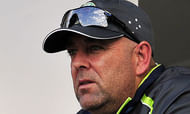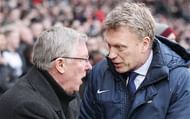Novak Djokovic split from part-time coach Todd Martin after the latter introduced several changes to the Serb’s game.
In school, we always seemed to be discomforted by teachers who tried to change our instinctive ways of studying. Though we never had any grudges against them – they did have our best interests at heart – we always counted those teachers who allowed us to expand our educational horizons without imposing their authority over us more favourably.
For most of us, our college and professional lives more than made up for having such unimpressionable faculty in school. Left to our own devices most of the time, we experimented and in the process tasted both success and failure.
But there are those select few, whose professional lives take them far, far away from the domain of academics and make them the cynosure of the world’s eyes, at the highest of professional stages. These professionals have instructors too to guide their way forward.
Sportsmen and sporting teams come foremost in this categorisation. They get in ‘specialised’ coaches to bring out the best in them and hone their inherent skills to perfection. They are also the ones who get prodded at all times with competition persistently keeping them on their toes. No matter how much seniority they might have in their CV, having a coach always somehow makes for having a value addition to the existing mix.
There are always a lot of candidates to choose and shortlist from. So many characteristics to consider before one can make one’s choice. Each coaching prospect, it is said brings in something different to the table along with their own idiosyncrasies. Some, not too dissimilar from the tough mould of teachers, deeply focused on emphasising ‘their way being the right way.’
Personal foibles aside, the nomenclature of coaches is however largely two-pronged. Based on their successes working alongside sportsmen and sporting teams on one hand, and on the other based on the successes of the athletes. But while the internal manifestations of communications between teams and players and potential coaches aren’t exactly made public, the process is one that remains long drawn-out and subject to extreme fragility at the start.
One can dot the field with examples. Of great players and teams teaming up with decent, non-overbearing coaches who have failed to sustain the talent of these players, and of decent players and teams pairing with exceptional yet severely imposing coaches who have nurtured and taken them to the highest of sporting peaks. There have also been great sporting names who have turned out to be meek as far as their coaching expertise is concerned with their aggressive temperament spoiling their sporting greatness and of mediocre sportsmen who have been the best in the coaching business merely by not being intimidating.
Tennis has seen the unraveling of several such partnerships where coaches have been tested and then barely months, days even, into the partnership they have been cast aside. Todd Martin and Novak Djokovic a few years previously, or more lately, Caroline Wozniacki and Thomas Hogstedt, are two of the more prominent coach-player pairs that fell out in the most unceremonious of manners.

Darren Lehmann redeemed the face of Australian cricket after Mickey Arthur’s infamous ‘homework’ episode in England.
Across sporting platforms, there have also been instances where conventionality and unconventionality have been gainers and losers equally. In cricket, non-conformist Sandeep Patil got Kenya rave recognition in the 2003 cricket World Cup while mild-mannered John Wright brought India to the brink of winning their second World Cup alongside helping them to get notable victories on shores overseas, both in the years preceding and following the World Cup. More recently, Darren Lehmann, despite not having an extensive Test cricketing resume and a typical brash Australian attitude, championed Australia through to a conquering Ashes win Down Under as did a modest Andy Flower who marshaled the English team to three back-to-back Ashes wins, just months ago.
And though Flower’s demise from fame to ignominy took mere months, the time-span between two Ashes series’, accounting for his polite removal by the upper echelons of English cricketing officialdom, there have been cases where coaches, regardless of their coaching attitudes, have had faced less-than polite ousters.
More than any other sport, football is one sport that’s more synonymous with such infamous plan of actions. And it’s in the flashy world of club football that coaching paradigms are subject to the most volatility with loyalties bought and sold with money ruling the roost. It’s a pattern with certain club owners who expect to see results year-after-year, as if taking match-wise audits of the money spent. Big or small club, it doesn’t matter. If the team fails to make it count, then rarely do managers at such clubs get to stay calm and get on with their jobs.

By all accounts, Sir Alex Ferguson was an aggressive coach who went on to make his name upon a never-accomplished pedestal in the history of EPL. But can Moyes replicate the feat? It remains to be seen.
Then there are those clubs which opt for stability over flashiness for their managerial candidates. They prefer managers who will last longer and get the team past the difficulties of their initial transitional phase, allowing full veto powers to the manager. These are also clubs which prefer to wait it out – case in point, David Moyes’ selection by Manchester United – rather than going for glam and glitz with high-profile names who, despite all accorded powers, in all likelihood wouldn’t want to continue with the club on a long-term basis.
No matter the problems ailing Manchester United, the most ardent of the club’s followers have thus committed their allegiance to the manager. But where his excellence at Everton – a decidedly mid-level club – was touted with much fanfare, his tactics at United have exposed the cracks within the team and his apparent inability to stem these cracks effectively especially when juxtaposed with what his predecessor, Sir Alex Ferguson, was able to achieve whilst milking the said available playing resources.
The so-called x-factor when it comes to the best coaching techniques thus seems be lost somewhere. All these examples are riddled with ambiguity and offer no clarity about what qualities a coach needs to have and what separates an outstanding coach from a merely good one – irrespective of whether their coaching tendencies run towards authoritarianism or an effusive, all-integrating school of thought.
For most parts, time does look to be the best indicator rather than name and fame of the coaching prospect. But since most coaching jobs require immediate results, time alone doesn’t really delve into bringing out the best out of the coaching pool. And even if time is an indicator as such, at what point does one pause the time-clock to validate whether a coach is working out or not?
The intuitiveness of the coach thus comes into the foreground where time falls into ambiguity. Somehow the coach who allows the player and the team under him to play their natural game always looks to be more welcome, no matter how tall the coach’s stature and reputation.
The stifling of players’ inherence by imposing the coach’s views somehow brings about wariness and discomfort, leading to friction between the two parties. More senior the player or members in a team, more pronounced is this feeling of scepticism and unsettlement.
An experience which, ironically, isn’t that different at all from the disconcertment of the student masses in the school rooms when facing well-intending yet misguidedly pushy teachers.
How did Novak Djokovic meet Jelena Ristic? All about the most admired couples in tennis
